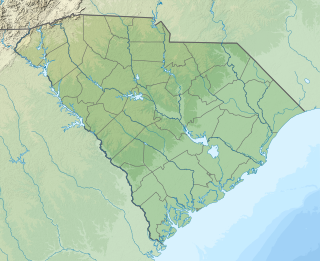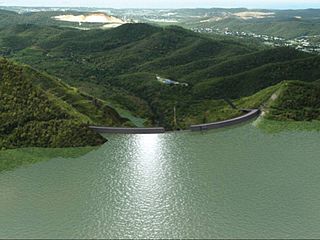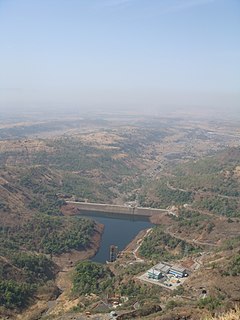
Lake Blalock is a reservoir in Spartanburg County, South Carolina, located on the Pacolet River about five miles north of Spartanburg. After its creation was authorized in 1976 by the Commissioners of Spartanburg Water System, Blalock Dam was constructed in 1983. The existing earthen dam is approximately 700 ft (210 m). long and 70 ft (21 m) high. It was originally designed for a normal operating pool of 700 feet (210 m), and the lake had approximately 35 miles (56 km) of shoreline. The existing spillway has a crest length of 270 ft (82 m).

Roller-compacted concrete (RCC) or rolled concrete (rollcrete) is a special blend of concrete that has essentially the same ingredients as conventional concrete but in different ratios, and increasingly with partial substitution of fly ash for Portland cement. The partial substitution of fly ash for Portland Cement is an important aspect of RCC dam construction because the heat generated by fly ash hydration is significantly less than the heat generated by Portland Cement hydration. This in turn reduces the thermal loads on the dam and reduces the potential for thermal cracking to occur. RCC is a mix of cement/fly ash, water, sand, aggregate and common additives, but contains much less water. The produced mix is drier and essentially has no slump. RCC is placed in a manner similar to paving; the material is delivered by dump trucks or conveyors, spread by small bulldozers or specially modified asphalt pavers, and then compacted by vibratory rollers.

Hickory Log Creek Dam is a gravity dam on the Hickory Log Creek which runs from northeast and north-central Cherokee County, Georgia, United States, south-southwest to the northeastern part of Canton, the county seat. It is a tributary of the Etowah River, which it meets shortly after crossing under Riverstone Parkway.
The Paradise Dam, also known as the Burnett River Dam, is a roller compacted concrete (RCC) gravity dam across the Burnett River, located northwest Biggenden and 80 kilometres (50 mi) southwest of Bundaberg in the Wide Bay-Burnett region of Queensland, Australia. Built for irrigation, the impoundment created by the dam is called Lake Paradise.
The Ingula Pumped Storage Scheme is a pumped-storage power station in the escarpment of the Little Drakensberg range straddling the border of the KwaZulu-Natal and Free State provinces, South Africa. It is about 22 km (14 mi) North-East of Van Reenen.

The Miyagase Dam is a dam on the Nakatsu River, a main tributary of the Sagami River in Aikō District, Kanagawa Prefecture, Japan. It straddles the border between the village of Kiyokawa, town of Aikawa and the former town of Tsukui.
Knellpoort Dam is a combined gravity & arch type dam located on the Riet Spruit, near Wepener, Free State, South Africa. It was established in 1989. Due to siltation, the storage capacity of the Welbedacht Dam reduced rapidly from the original 115 million m3 to approximately 16 million m3 during the twenty years since completion. This reduction in storage created problems in meeting the Bloemfontein water demand at an acceptable level of reliability and as a result, the 50 m high Knellpoort Dam was completed in 1989. It was the first arch gravity roller compacted concrete (RCC) dam in the world and comprises almost 64 600 m3 rollcrete and 14 200 m3 concrete with a gross storage capacity of 136 million m3.

The Portugués Dam is a roller-compacted concrete thick arch dam on the Portugués River, three miles (5 km) northwest of the city Ponce, in Barrio Tibes, Ponce, Puerto Rico. Construction on the dam began in April 2008, soon after the U.S. Army Corps of Engineers, Jacksonville District awarded the Spanish firm Dragados USA, a division of Grupo ACS, with a $180 million contract in March 2008 to build the dam.

The San Vicente Dam is a concrete gravity dam on San Vicente Creek near Lakeside and 25 km (15.5 mi) northeast of San Diego, California. The dam was built between 1941 and 1943 and created San Vicente Reservoir for the purpose of municipal water storage, flood control and recreation. Although the reservoir is fed by run-off, its main source is the First San Diego Aqueduct. In June 2009, construction to raise the height of the dam by 117 ft (36 m), in order to more than double its reservoir size, commenced. It is the largest dam raise in the United States and largest roller-compacted concrete dam raise in the world. The dam raise project was originally set for the end of 2012, but was completed in early 2014. Efforts to replace the water supply pipelines and prepare the reservoir for the public will be underway until 2015-2017.

The Alpe Gera Dam is a gravity dam on the Cormor River in a lateral valley of Valmalenco 17 km (11 mi) northeast of Sondrio in the Lombardy region of Italy. It is 174 m (571 ft) tall and supports a 35 MW hydroelectric power station.

The Miel I Dam, officially known as the Patángoras Dam, is a gravity dam on La Miel River just south of Norcasia in Caldas Department, Colombia. The dam was constructed between 1997 and 2002 for the primary purpose of hydroelectric power generation. At the time of its completion, the dam was the tallest roller-compacted concrete (RCC) dam in the world but was surpassed by the Longtan Dam in 2009.

The Okukubi Dam (億首ダム) is a trapezoidal cemented, sand and gravel (CSG) dam on the Okukubi River in Kin, Okinawa Prefecture, Japan. Construction began in 2009 and its reservoir was filled by 31 March 2013. It is the first trapezoidal CSG-type to be constructed as a main dam in the world. Its purpose is to provide flood control and water for municipal use along with the irrigation of 70 ha of land.

The Jiangya Dam is a concrete gravity dam on the Loushui River, located 50 km (31 mi) northeast of Zhangjiajie in Hunan Province, China. The primary purpose of the multi-purpose dam is flood control but it also generates hydroelectricty, supplies water for irrigation and municipal use and improves navigation.

The Longshou II Dam, also referred to as Longshou No. 2, is a concrete-face rock-fill dam on the Heihe River, located 35 km (22 mi) southwest of Zhangye in Gansu Province, China. It is part of the Gansu Heihe Rural Hydropower Development and supports a 157 MW power station. The dam's first feasibility study was carried out in 2000 and river diversion construction began in December 2001. In June 2002, the river was diverted and in September that year, filling of the dam's body began. On 17 August 2004, the first generator was operational with the rest by the end of the year. The 146.5 m (481 ft) high dam withholds a reservoir with a capacity of 86,200,000 m3 (69,883 acre⋅ft). It's spillway is located on the right bank and is a controlled chute type with a discharge capacity of 2,696 m3/s (95,208 cu ft/s). Water is delivered to the dam's power station downstream via a 1.7 km (1 mi) long tunnel. The dam is located upstream of the Longshou I Dam, an 80 m (262 ft) tall double-curvature arch dam with an installed capacity of 52 MW. Upstream is the Xiaogushan Dam, a gravity dam which diverts water to a 102 MW power station.

The Suofengying Dam is a concrete gravity dam on the Wu River, 44 km (27 mi) northwest of Guiyang in Guizhou Province, China. It is located 35.5 km (22 mi) downstream of the Dongfeng Dam and 74.9 km (47 mi) upstream of the Wujiangdu Dam. The primary purpose of the dam is hydroelectric power generation and it supports a 600 MW power station. Construction on the dam began on 26 July 2002 and on December 18 of that year, the river was diverted. Pouring of roller-compacted concrete into the dam's body began on 14 January 2004 and in June, the dam began to impound its reservoir. On 18 August, the first generator was operational and the last two in 2005. The 121.8 m (400 ft) tall dam creates a reservoir with a capacity of 201,200,000 m3 (163,115 acre⋅ft). The dam's power station is located on its right bank and contains three 200 MW Francis turbine-generators.

The Daguangba Dam is a multi-purpose dam on the Changhua River in Hainan Province, China. It is located 35 km (22 mi) east of Dongfang. As the primary component of the Daguangba Multipurpose Project, the dam was constructed between 1990 and 1995. It serves to provide water for both hydroelectric power generation and agriculture. It supports a 240 MW power station and supplies water for the irrigation of 12,700 ha. It is also the largest dam and hydroelectric power station in Hainan.

Changuinola I Dam, is located in district of Changuinola, in the Province of Bocas del Toro, in the western part of Panama. It is the largest roller-compacted concrete arch-gravity dam in the World.

Ghatghar Dam refers to two associated gravity dams built using roller-compacted concrete, the first use in India. They are situated in Ghatghar village in Ahmednagar district Maharashtra, India. Both dams create a lower and upper reservoir for the 250 MW pumped-storage hydroelectric power station. The upper Ghatghar dam is 15 m (49 ft) tall and on the Pravara River, a tributary of Godavari river. The lower Ghatghar dam is 86 m (282 ft) tall and located on the Shahi Nalla which is a tributary of Ulhas River to the south west of the upper reservoir in a steep valley. The hydro power project diverts Godavari river basin water outside the basin area to a west flowing river of Western ghats.

The Lizhou Dam is a run-of-the-river hydroelectric arch dam on the Muli River in Muli Tibetan Autonomous County, Sichuan Province, China.
Spring Grove Dam is an A roller compacted concrete (RCC) dam with an earth embankment located on the Mooi River in the KwaZulu-Natal north west of the town of Nottingham Road in South Africa. Construction commenced in 2011 and was officially opened on 19 November 2013. It has a full capacity of 138.5 million cubic meters of water and serves primarily for Municipal and industrial use.















